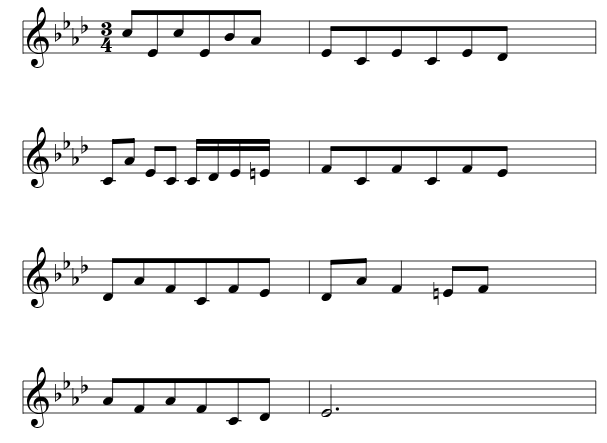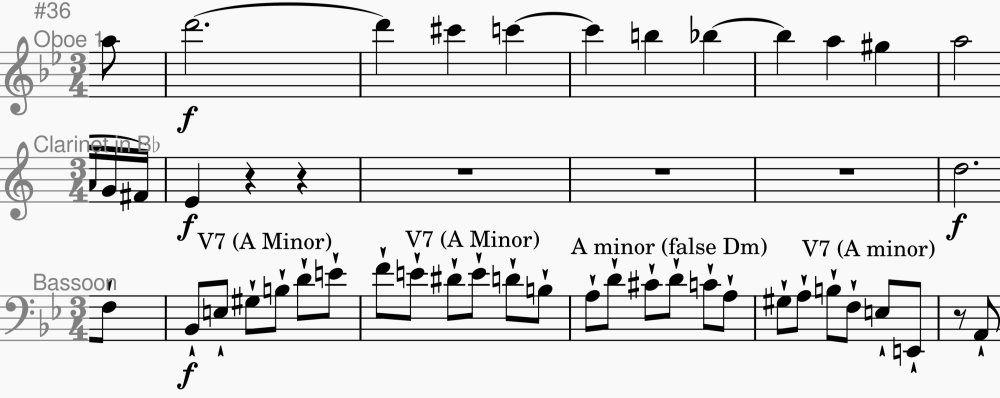All Activity
- Past hour
-

Oboe Concerto
GospelPiano12 replied to GospelPiano12's topic in Incomplete Works; Writer's Block and Suggestions
I like this idea! I will definitely start exploring these variations you've mentioned. I think this would be great!! Especially as I start thinking about instrumentation and voicing and color. Of course, your suggestions are always welcome. Thank you. Seems like I have a lot of work on my hands lol -
.thumb.png.8b5b433a341551e913a34392660bc95b.png)
Oboe Concerto
PeterthePapercomPoser replied to GospelPiano12's topic in Incomplete Works; Writer's Block and Suggestions
Hey @GospelPiano12! I think starting out with a really simple phrase like this is a great way to start! In my own experience, I've always relied on being able to come up with variations of the main melodic idea that my piece is based on, and in the case of a concerto type of piece, virtuosic variations. Even if your ultimate form isn't going to be a theme and variations, being able to pre-compose various different versions of your main theme will get you far in terms of giving you the ideas you need to put the piece together. So, what you have here is a really great simple idea that you can easily subject to virtuosic variations by inserting notes in between the melody notes you already have: This could also potentially lead to the formation of ostinati or repeating accompanimental figures which can give your piece some rhythmic drive! Also, since you're writing a concerto for a wind instrument, it's important to remember to give your soloist choice places to breathe. Most of my own concerto type works have been for piano and orchestra. I've written things for Violin and Piano or Violin and Harpsichord, but they were short (and the former, microtonal). I think you can, if you want, use this thread as a place to bounce your ideas off of the community as you make progress. If you're comfortable I can make suggestions like this periodically. I always have more ideas for more variations! Like they said in the movie "Blazing Saddles" - "My mind is a .. a raging torrent! Flooded with rivulets of thought .. cascading into a waterfall of creative alternatives!" LoL - Today
-
PeterthePapercomPoser started following Oboe Concerto
-
GospelPiano12 started following Oboe Concerto
-
Good Evening All, I've set out to write an oboe concerto, but I wrote this fragment and realized that I don't know how to write a concerto...any advice/tips? Also, please don't come at me for the notation...it's giving 6/4, but I'm just in the beginning stages of brain storming Oboe sketches.mp3
- Yesterday
-
Many thanks for your input! I feel your enthusiasm for these types of posts. They are, after all, a kind of public challenge for which we can showcase our knowledge while also collaborating with others. I would personally like to get more involved with such things. It would be awesome if we maintained, as a group, a repository for knowledge in the art of composition - for example how to consider voice leading against chromaticism. No doubt we would need distinct zones for functional harmony and otherwise to accommodate people's diverse ascetic interests on this forum. That aside, I had seen E as a common tone opportunity for a pedal, potentially, but that seemed a little boring and unadventurous. However, as you suggest, perhaps it is neither necessary to add further complexity if the outer voices are already doing something interesting and distinct. Nonetheless, I thought I would rise to the challenge. I like your solution - that largely moves in thirds with the base and for which there are opportunities for further refinement by recycling some motifs from elsewhere in the piece. I am unsure about the treatment of the third bar as E7, considering the bass resolves to A minor, although the only note that may undermine this is the D in the clarinet during the third beat of that bar. You're right about the b natural in the bassoon - that was an oversight on my part. I will have a tinker over the coming days and report back here with what I've come up with.
- Last week
-
Markus Boyd started following Call for perspectives on a passage
-
therealAJGS started following The Trials of PATIENCE, a solo piano song with sheet music.
-
honestly probably the best song I've ever made. Basic, but good.
- 1 reply
-
- piano
- incidental
-
(and 2 more)
Tagged with:
-
TristanTheTristan joined the community
-
I think I broke it.
-
Three Part Songs to Poems by G.M. Hopkins Free Sheet Music by Robert C. Fox for Various Instruments | Noteflight I'll get the other two in! Here's a start. The Windhover.
-
This is actually a personal narrative. I generated the character names as pseudonyms for privacy reasons (so I don’t get yelled by the actual people.) This is all written in the perspective of Ross (the pseudonym for me). As you could see, this is a part three out of four parts and I have the fourth act already written. I just have to edit it and add the names. Feel free to check out the first and 2nd movement. It has some musical context along with the storyline. But thank you for listening to it. I always wanted an analysis or at least feedback of the piece. So definitely thank you
-
Hey Markus, I haven't seen you in a while, glad to hear you're still writing 🙂 I love these kinds of posts. It's really cool to hear your problem, then for me to try it out and mess around on it. Thanks for posting your thought process, as I can start with yours and see where that takes me. One idea I had was to let the clarinet be a pedal point for the E7. I had F for the "Dm" chord measure, but it didn't sound good to me. I liked the absence of the clarinet here, so maybe keep it simple if this thought leads you somewhere. For me, it helps to see the entire 4 bar phrase as E7. I know that one spot is tricky, but it just seems like a big cadence to Am (Also, this whole transition from Bb to F is wonderful and very smooth. Is it Am - C7 - F? I like the iii - V7 - I movement). If I look at it as E7 with a bunch of chromatics, it's easier to think about the clarinet. I came up with this pretty quick, I'm sure the notes could be tinkered with. I don't remember, but little rhythmic motifs you may have used could go well with the clarinet, I just came up with something simple. Oh, and our music player sucks lol. It's hard to go to a certain spot within a piece, so I think I've heard the first minute or so several times 😄 Hopefully some of these thoughts are useful 🙂 Great stuff, keep us updated! P.S. The bassoon starts on B nat. right?
-
.thumb.png.f5c7c1a6a554eeeefdce321d089f5901.png)
Please click on this, I have a song for you.
therealAJGS replied to therealAJGS's topic in Electronic
-
I have been working on a woodwind trio for which I have written a passage which has been confusing at best. As I tend to be guided by my ear when writing, I sometimes write things that sound aligned with my expectations but which I do not entirely understand! This seems to be amplified when I use chromaticism, as in this example. I think I now understand, but I am a bit stuck on what to write in the inner voice. My understanding is that the first two bars mark the dominant of A minor, with a D sharp chromatic inflection in the bass in the second but which resolves in the third beat. And the third bar is I in A minor, with a C sharp chromatic inflection implying d minor but resolving to an A minor chord. This proceeds to the V7 of A minor in preparation for the cadence in Am (but in fact resolves to F major). The upper voice descends chromatically in such a way that complicates the harmony and opportunities to fill in the middle voice. My low experience with chromaticism really shows its true colors here. I have attached the audio - the passage in question is from the 50 second mark. Would be great to hear other's perspectives.
-
Go to musicteachergifts.com to enter. thanks.
- 4 replies
-
- competiiton
- feedback
-
(and 1 more)
Tagged with:
-
how do i make FL studio less laggy?
-
I could enter, I just don't know how to submit and probably won't have enough.
- 4 replies
-
- 1
-

-
- competiiton
- feedback
-
(and 1 more)
Tagged with:
-
this was originally going to be a funk but became this, also was semi inspired by literal Learn to fly 3.
-
Thanks for pointing out the fact that I have exceeded the lower range of the organ’s manuals. I had been confused with the “Scientific Pitch Notation” (SPN)’s consideration of middle C as C4 while for organs the same note middle C is considered C3. Thus I have assumed I could go down to C1 in SPN but it is C1 for organs which is 1 octave above, i.e. like SPN’s C2. I revised the piece to keep within the lower range of C2.
-
You could send @Morgri a personal message by clicking the "Message" button in their profile!
-
Keiko joined the community
-
Hello! What a great piece! My ensemble would love to perform some of the movements, though we would have to ask to rearrange for a slightly different instrumentation (if the composer is interested and willing!) What’s the best way to contact the composer?
-
Behold, My Servant Shall Prosper Free Sheet Music by Robert C. Fox for Various Instruments | Noteflight And Quam Olim II from Requiem. Requiem In Bb Major-Quam Olim II Free Sheet Music by Robert C. Fox for Various Instruments | Noteflight
-
If I learned about this last year I could have entered 😭
- 4 replies
-
- 1
-

-
- competiiton
- feedback
-
(and 1 more)
Tagged with:









